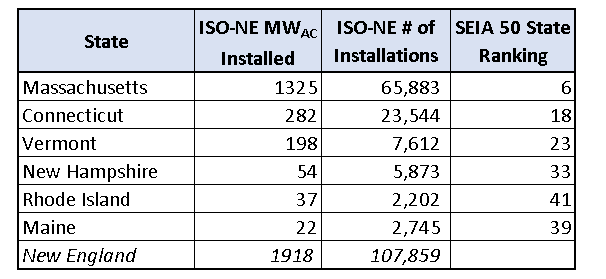This is my third installment dealing with solar power in NH. In the first two posts, I provided some basic concepts about solar power, as well as information about NH solar potential and the large solar farm in Peterborough. As I drive around New England, I see solar installations popping up everywhere, especially in Massachusetts and Vermont. Rhode Island recently passed new laws that will continue to support solar in a big way so I thought it would be useful to do a comparison between the various New England states to see how New Hampshire stacks up.
The first information I sought out was how much installed solar each state has. There are several sources for this information, which have different degrees of reliability, ease and cost of accessibility, and different bases for the rankings. Direct comparison of the various sources is complicated by the different ways of rating the power outputs of solar plants. As explained in my previous post, solar photovoltaic (PV) installations produce direct current (DC) electricity and the rating of solar PV operations is often given as the combined DC output capacity, in kilowatts (kW) or megawatts (MW) DC, of the panels under the standard test conditions of 1000 W/m2 irradiation and temperature of 25oC – conditions known as one peak sun (see an earlier post for an explanation of irradiation and the peak sun hour concept). To feed electricity into the grid, the DC electricity needs to be converted into alternating current (AC) through a device called an inverter. During this conversion, there are losses through the electrical system and wiring. These losses are typically of the order of 5 to 10%, so the peak AC output of a solar system, in in kW or MW AC, can vary from 90 to 95% of the DC rating. However, there are also performance losses due to dust on panels, degradation of the panels over time, and elevated temperatures. In my calculations, I typically assume that the peak output of AC electricity from a solar system is about 80% of its DC rating.
In searching for installed solar capacity information, the most useful I found was the 2016 data from ISO-NE, which is included in the table below, along with the 50 state ranking carried out by the Solar Energy Industries Association (SEIA). I have also included a chart from the ISO-NE Final 2017 Forecast that shows the growth in New England PV installations since December 2013. The ISO-NE data (reported in MWAC) shows that Massachusetts is clearly on top of the New England installed solar rankings, followed by Connecticut and Vermont. Massachusetts is also ranked #7 out of the 50 states in installed solar capacity. California, as one would expect, is ranked #1. In the 50-state ranking, NH is presently in 33rd position.
Source: ISO-NE
Even though Vermont’s installed solar capacity is a small fraction of that of Massachusetts, I was still impressed at how much solar they have installed, so I calculated the installed solar capacity on a per-person basis and generated the chart below. In this ranking, Vermont rises to the top, with installed solar capacity of 318 W AC per capita. To put this into perspective, this means that Vermont has installed the equivalent of more than one solar panel for each person in the state (modern solar panels have a DC rating of 300 W and an AC output rating of ~240 W (after losses)). This is a little lower than the California figure of ~370 WAC, but I’m still impressed.
Source: ISO-NE and Census.gov
In terms of installed solar, NH is very much at the back of the pack, but there are other solar ranking systems out there. I am a fan of the state rankings carried out by the folks at Solar Power Rocks. They order states on the basis of regulations, incentives, investment returns, and cost of electricity (among other factors that are supportive of solar power). In their ranking, which I have shared below, NH places fairly high, coming in at #10. The other New England states, MA, RI, VT and CT, also appear in the top 10, while Maine is found in 23rd position.
The specific scorecard for NH is reproduced below: it is clear that with a “B” grading, NH has a lot going for it in terms of support for solar power. The factors in NH’s favor include:
- High electricity prices;
- Net metering;
- The Federal solar tax credit – presently 30% of the cost for installing a PV system;
- Production credits through the sale of renewable energy credits;
- State rebates on the costs for installing solar.
Source: SolarPowerRocksNH
There has been a fair amount of news recently about the NH state rebates available from the Public Utilities Commission. The program is presently on hold due to its record demand and concerns about sufficient funding. Nevertheless, there is much in favor in terms of installing solar in NH, and we should be taking advantage of this. In my next posts, I will take a close look at how these factors play out in considering whether to install solar on your home in NH. So, until next time, remember to turn off the lights when you leave the room.
Mike Mooiman
Franklin Pierce University
mooimanm@franklinpierce.edu





No comments:
Post a Comment
Please feel free to comment but note that I have added a verification step to avoid the large amount of spam that can make its way into the comment area. An annoying but necessary step these days.